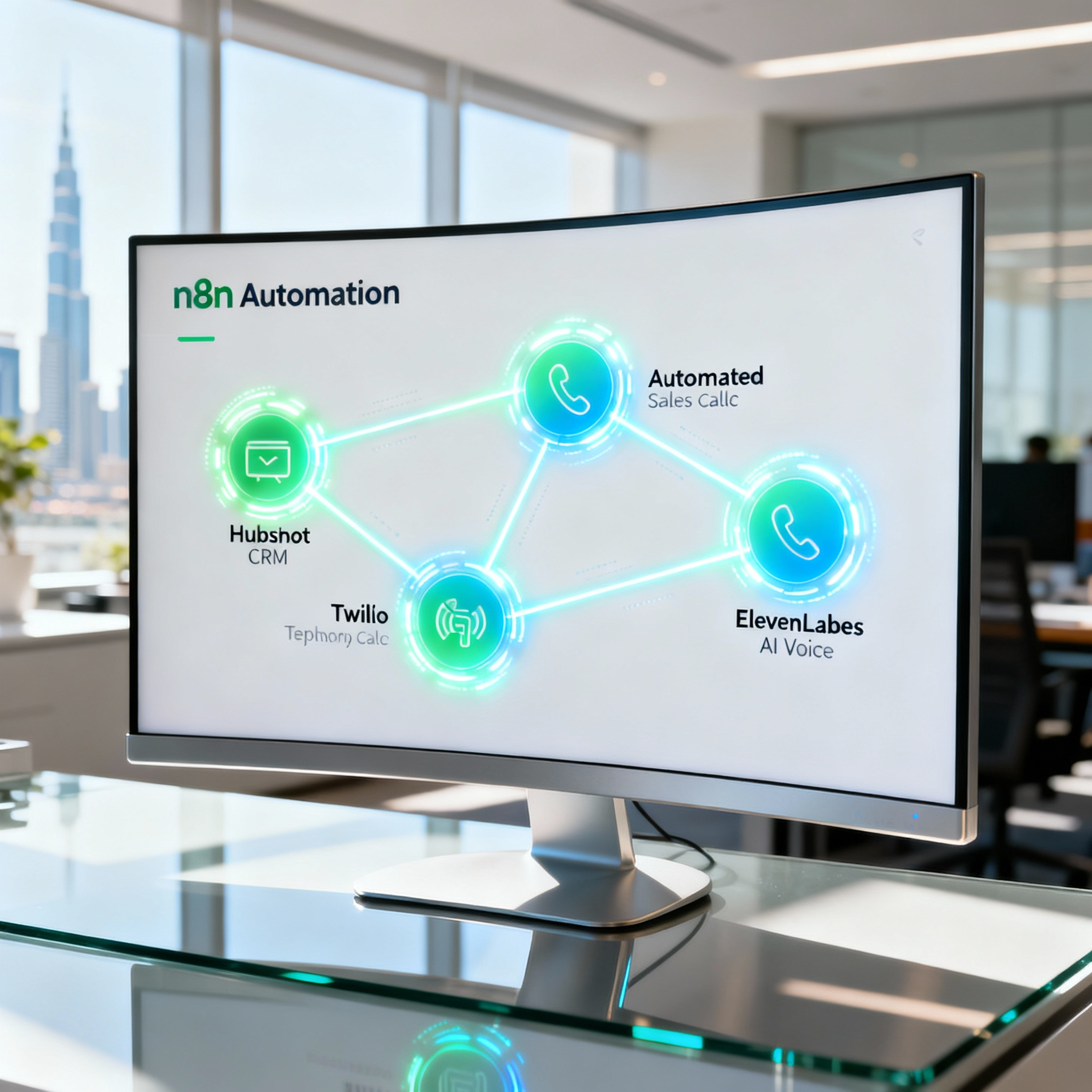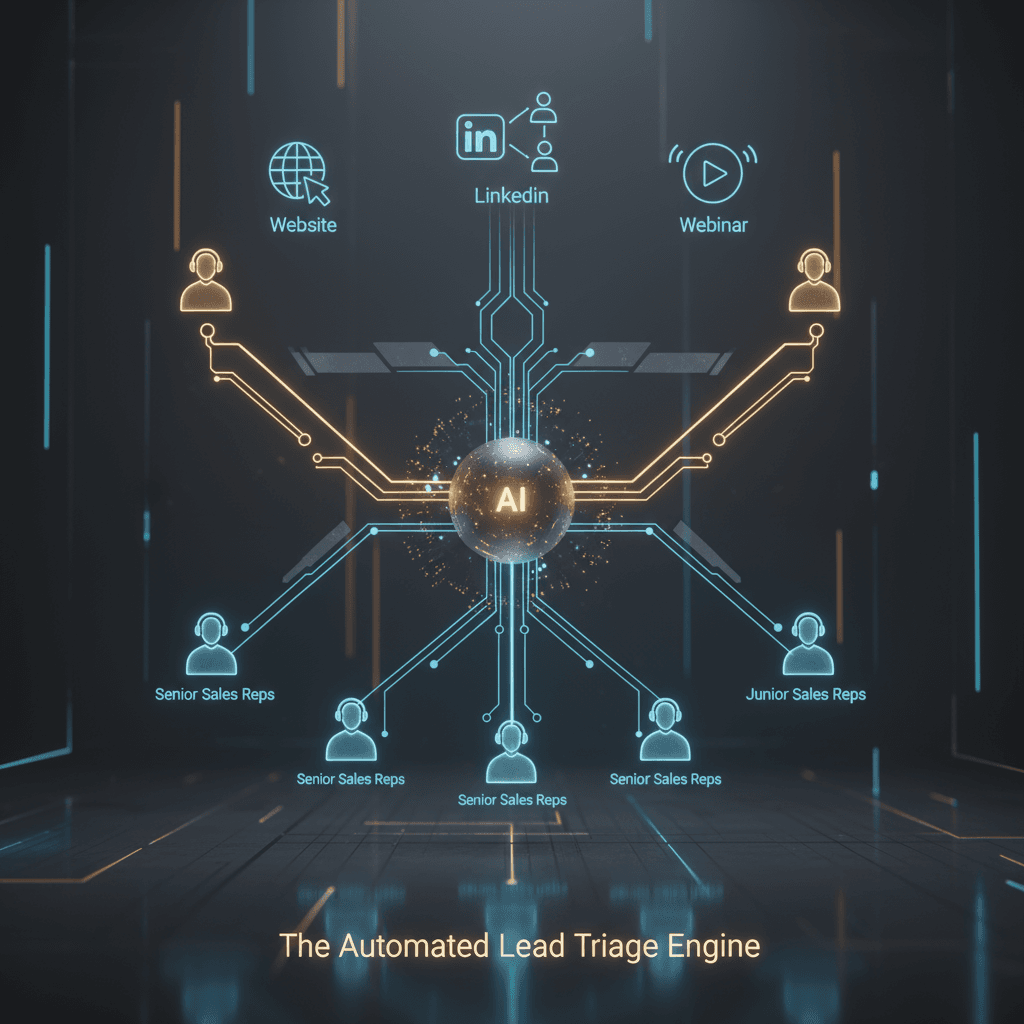The UAE Voice AI Playbook: How to Build a Compliant AI Sales Agent with n8n and Twilio
Your SDR team's costs are climbing, but their output isn't. You're paying a full-time salary for someone to spend most of their day dialing, getting voicemails, and manually logging call notes. This operational drag means your pipeline isn't growing as fast as it could be. This playbook provides the operator-level steps to build and deploy a compliant AI Sales Agent using low-code tools, so you can automate appointment setting and fill your sales team's calendar without hiring another person.
Key Outcomes
- Scale Outreach Instantly: Go from 80 manual calls a day to over 800 automated ones, 24/7.
- Ensure UAE Compliance: Automatically check the National Do Not Call Registry (DNCR) before every single dial.
- Cut Operational Costs: Reduce your cost-per-appointment by up to 85% compared to a fully-loaded human SDR salary.
- Integrate Seamlessly: Connect directly to your CRM (HubSpot, Salesforce) for real-time activity logging and lead list management.
- Deploy in Days, Not Months: Use our framework to get your first agent live and booking meetings in under a week.
The technology to achieve this is no longer just for enterprise teams with massive budgets. With accessible APIs and powerful automation platforms, any operations leader can wire together a powerful voice AI system. It's time to stop talking about it and start building.
The Tech Stack: Your AI Agent's Building Blocks
To build a robust AI voice agent, you need four key components that work in concert. Think of it as a small, specialized team: the Brain, the Voice, the Phone Line, and the Memory.
- The Brain (Orchestration): n8n
This is the central nervous system of your operation. A self-hosted n8n instance gives you full data control and connects all the other services. It tells the agent who to call, what to say, and what to do with the outcome. - The Phone Line (Telephony): Twilio
Twilio provides the core infrastructure for making and receiving calls programmatically. You'll use it to acquire a local UAE phone number and manage the call connections. - The Voice (AI Model): Bland.ai or ElevenLabs
This is where the magic happens. These APIs provide hyper-realistic, low-latency text-to-speech and speech-to-text, allowing for natural, fluid conversations. They can understand interruptions and respond in milliseconds. - The Memory (CRM): HubSpot or Salesforce
Your CRM is the source of truth. The n8n workflow will pull contact lists from your CRM and, more importantly, push call logs, transcripts, and dispositions back into the contact's record.

The 5-Step Implementation Framework
Here’s how you can go from concept to live calls. This framework breaks the process down into manageable steps that a non-developer can execute.
Step 1: Set Up Your Core Infrastructure
First, get your tools in place. This means signing up for accounts with Twilio and your chosen AI voice provider (like Bland.ai). Purchase a local UAE phone number through the Twilio console. For maximum control and data privacy, we recommend setting up a self-hosted instance of n8n on a service like DigitalOcean. This is a core part of how you can build an AI workforce that you truly own.
Step 2: Wire the Basic n8n Workflow
Start by mapping the flow. Your n8n workflow will have a few key nodes:
- Trigger: This can be a schedule (e.g., "run every morning at 9:05 AM") or a webhook from your CRM (e.g., "new lead added to this list").
- Fetch Contacts: Use the HubSpot or Salesforce node to pull a list of contacts to call for the day.
- Loop: Use the "Split in Batches" node to process one contact at a time.
- Initiate Call: Use the Twilio node to start the outbound call to the contact.
Step 3: Script the Conversation Flow
Your agent is only as good as its script. Don't make it a rigid monologue. Instead, design a flexible conversation tree that can handle different responses. Here is a simple, effective framework for a B2B qualification call.
| Stage | Agent's Goal | Example Script Snippet |
|---|---|---|
| Opener | Identify and state purpose clearly. | "Hi [FirstName], this is Sarah from [Your Company] calling on a recorded line. Do you have 30 seconds?" |
| Qualifier | Confirm you're speaking to the right person. | "I saw your company works in [Industry], and I was hoping to speak with the person in charge of [Department]. Is that you?" |
| Value Prop | State a clear, benefit-driven value proposition. | "We help companies like yours cut their cloud infrastructure costs by about 20% without changing providers. Is that something on your radar?" |
| Call to Action | Book the next step (the demo). | "Great. I can send over a calendar link to book a 15-minute demo with our lead engineer. What's the best email for you?" |
| Objection Handling | Address common pushback. | "Not a good time? Understood. Is there a better day next week to briefly reconnect?" |
Want our pre-built n8n workflow template? Book a 15-min call, and we'll walk you through our production-ready AI Voice Agent to get you started faster.
Step 4: Integrate the AI Voice & Logic
This is where you connect your voice API. Within your n8n workflow, the Twilio node will point to an endpoint that hosts your conversation logic. When the contact speaks, Twilio sends the audio to your AI voice provider (e.g., Bland.ai), which transcribes it to text. Your n8n workflow then uses conditional logic ("IF nodes") to decide which script branch to follow and sends the text response back to the API to be converted to speech. This entire loop happens in under a second.
Step 5: Log Outcomes & Ensure Compliance
After each call ends, the final step is to log the outcome. Use the HubSpot/Salesforce node in n8n to:
- Create a new "Call" activity on the contact's timeline.
- Add the full call transcript to the activity notes.
- Update a custom property like "Lead Status" to "Meeting Booked" or "Not Interested."
- Most importantly, check their number against your internal "Do Not Call" list and the UAE's official DNCR if they request it.
The UAE Compliance Checklist: Staying on the Right Side of the TDRA
Operating in the UAE requires adherence to specific regulations from the Telecommunications and Digital Government Regulatory Authority (TDRA). Building these checks into your automation is non-negotiable. It’s a key part of our mission at Future & Happiness to build responsible AI.

- ✅ DNCR Check: Before initiating any call, your workflow MUST perform a real-time check against the National Do Not Call Registry. If a number is on the list, the workflow should halt immediately for that contact.
- ✅ Permitted Calling Hours: Program your workflow to only trigger calls within acceptable hours, typically between 9:00 AM and 9:00 PM in the UAE.
- ✅ Clear Identification: Your script’s opening line must clearly state the name of your company and the purpose of the call. The agent cannot pretend to be human.
- ✅ Recorded Line Notification: Explicitly state that the call is being recorded for quality or training purposes.
- ✅ Simple Opt-Out: The agent must be programmed to understand and act on requests like "take me off your list" or "don't call me again." This should automatically add the contact to an internal do-not-call list.
Frequently Asked Questions (FAQ)
Is it legal to use AI for cold calling in the UAE?
Yes, provided you comply with TDRA regulations. This includes respecting the National Do Not Call Registry (DNCR), calling within permitted hours, clearly identifying your company, and providing an opt-out mechanism. Non-compliance can lead to significant fines.
What are the costs of a self-built AI voice agent?
Your primary costs are API fees. A typical breakdown per hour of calling might be: ~$1 for Twilio, ~$3-4 for a premium AI voice like ElevenLabs, and ~$1 for n8n hosting. Compared to a human SDR salary of 20,000-30,000 AED/month, the cost savings are substantial.
How do I create a realistic AI voice?
Services like ElevenLabs and Bland.ai are leaders here. They offer "voice cloning," allowing you to create a custom AI voice from just a few minutes of audio, or you can choose from a library of hyper-realistic stock voices. The key is low latency, which makes the conversation feel natural.
What's the difference between Bland.ai and Twilio Voice AI?
Twilio provides the core telephony infrastructure (the pipes). Bland.ai is a specialized AI conversation provider that runs on top of telephony systems like Twilio. You can use Twilio's own AI tools, but services like Bland often offer more advanced conversational capabilities out of the box.
How do you connect Twilio to n8n?
n8n has a dedicated Twilio node. You connect it by providing your Twilio Account SID and Auth Token from your Twilio dashboard. Once connected, you can use the node to initiate calls, send SMS messages, and more, directly from your workflow.
Can AI make sales calls effectively?
Yes, for specific tasks. AI agents excel at top-of-funnel activities like lead qualification and appointment setting. They can handle hundreds of calls without fatigue, consistently follow the script, and handle initial objections, freeing up human sales reps to focus on closing deals. One of our clients went from booking 5 demos a week with a human SDR to 22 demos a week with an AI agent.
Conclusion: Your 3-Step Action Plan
You now have the playbook to build a powerful asset for your business. An AI voice agent isn't about replacing humans; it's about augmenting your team to achieve a level of scale and efficiency that was previously impossible. Here's how to start:
- Audit Your Process: Map out your current lead qualification and appointment setting process. Identify the exact script, criteria, and outcomes you want to automate. Good data in, good results out.
- Sign Up for a Free n8n Cloud Account: Before committing to self-hosting, get a feel for the platform. Sign up for the free tier of n8n, Twilio, and an AI voice provider to build a small proof-of-concept.
- Book a Strategy Call: If you want to accelerate your build, schedule a call with our team. We'll give you our battle-tested n8n template and help you map the integration with your CRM.



